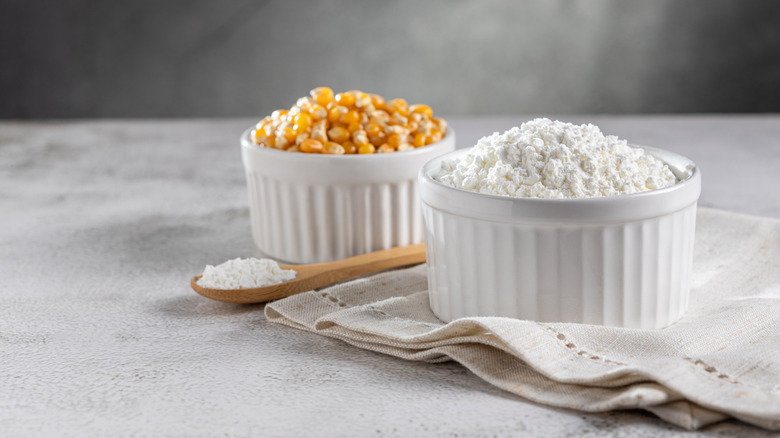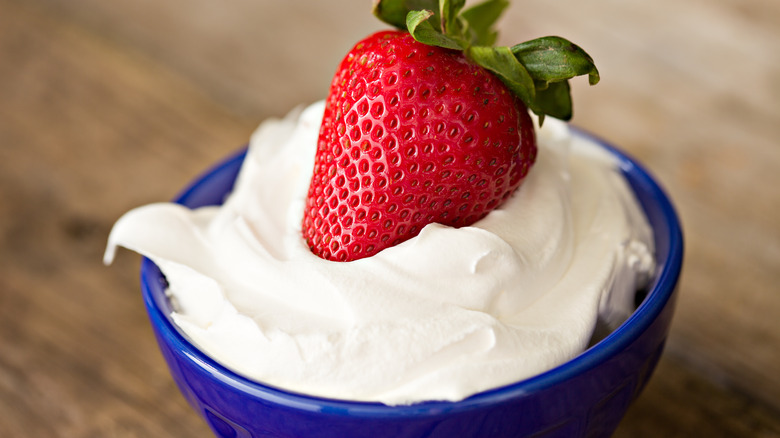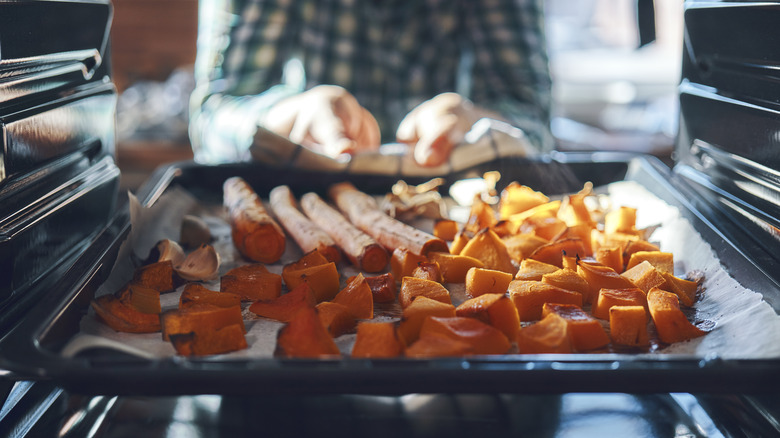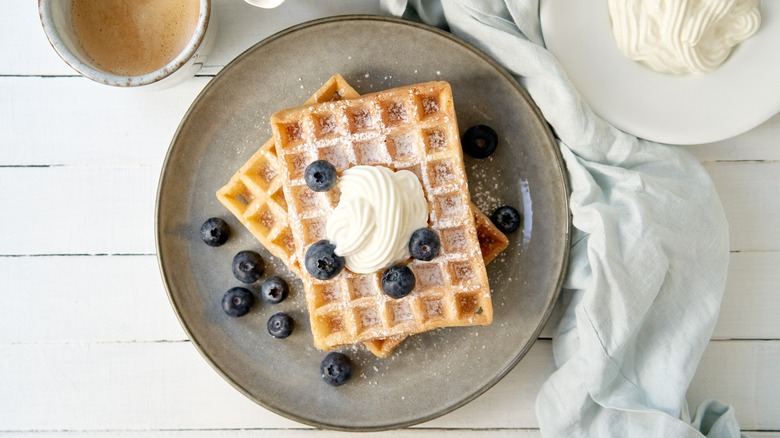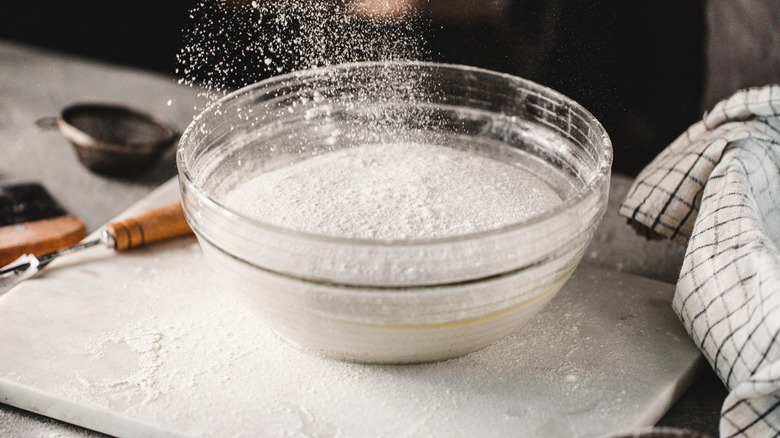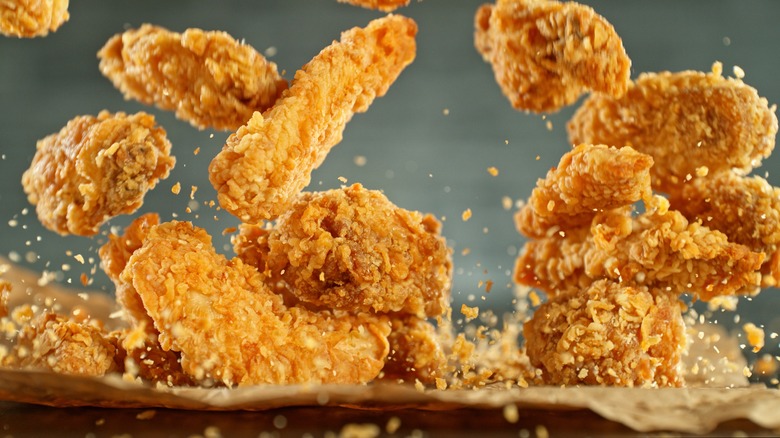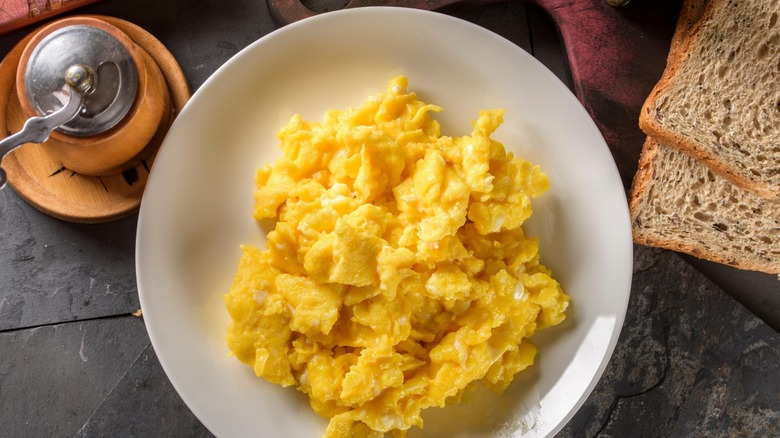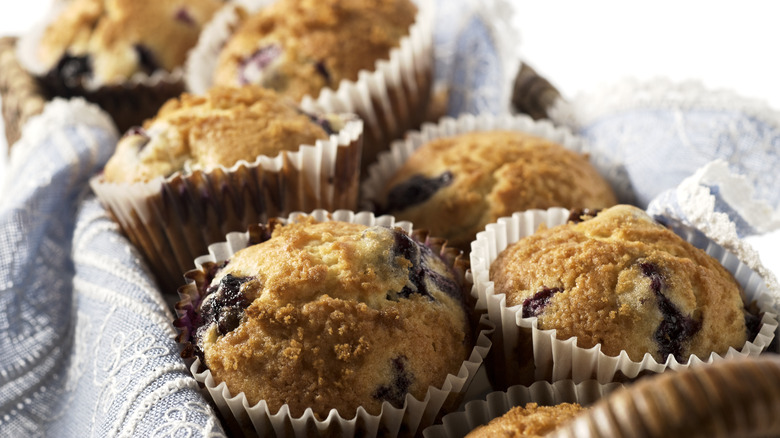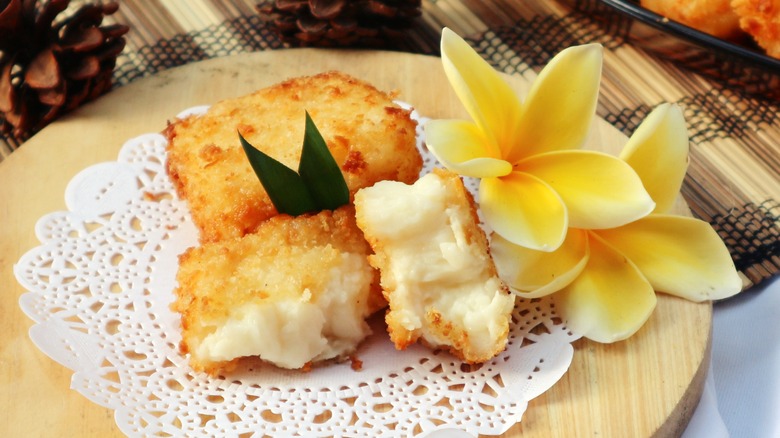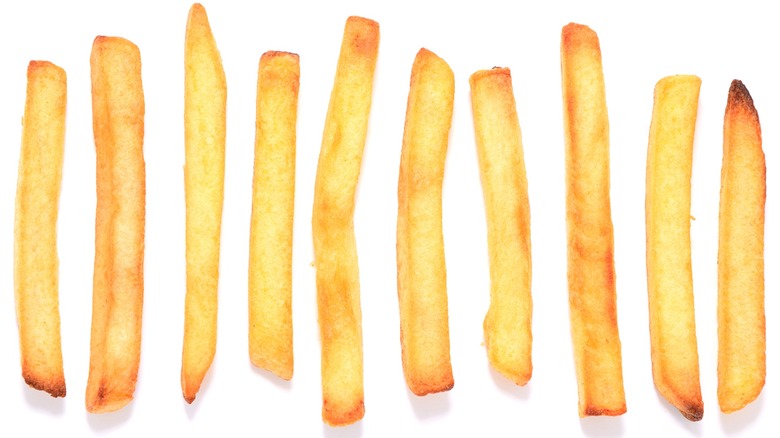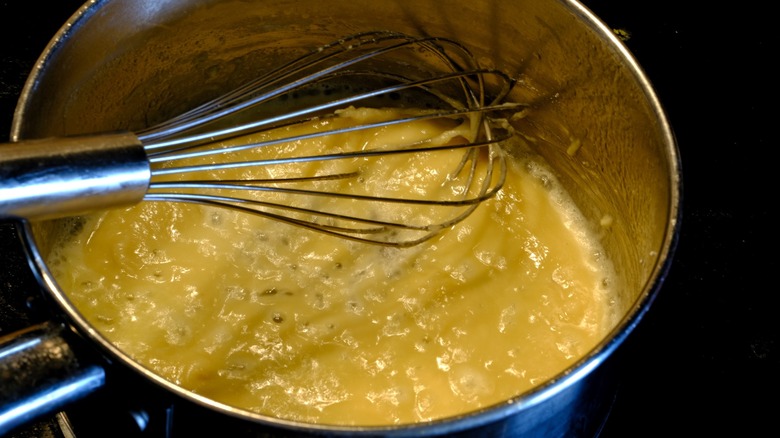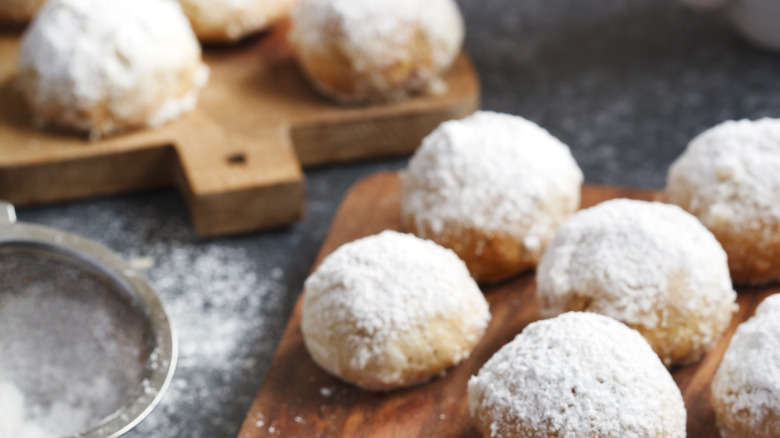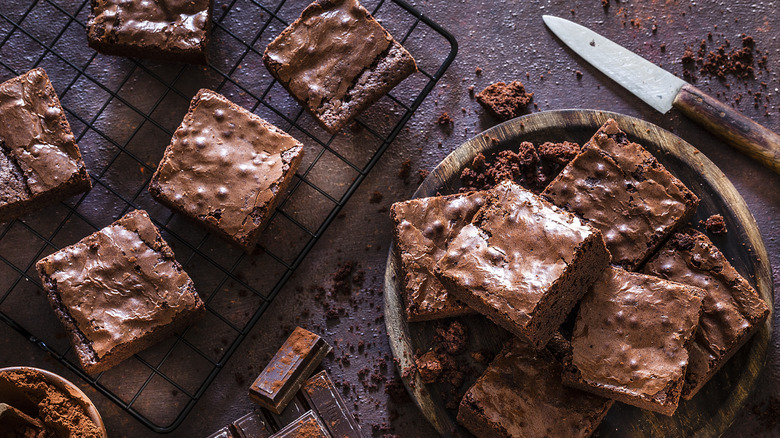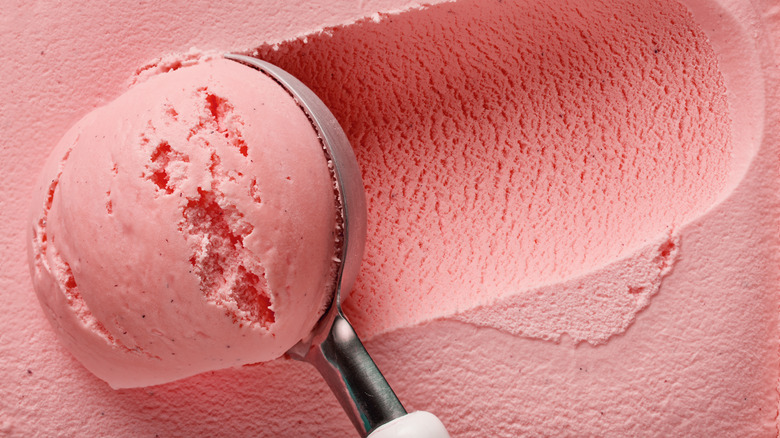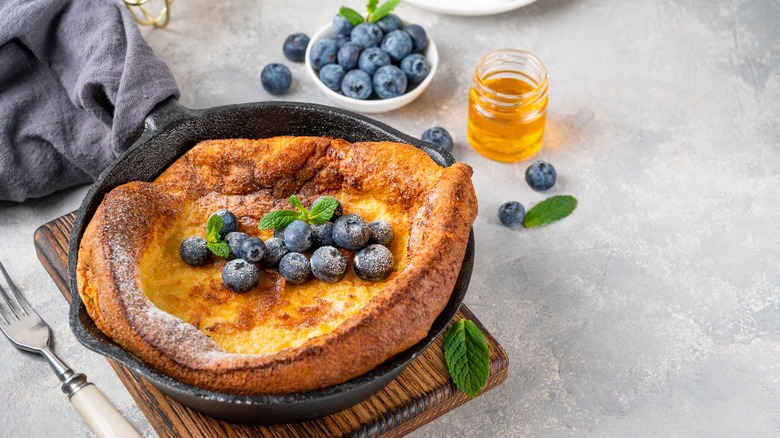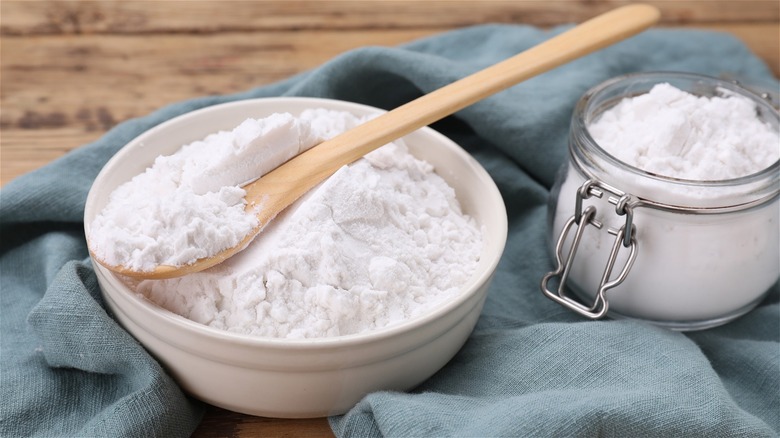15 Things You Never Knew Cornstarch Could Do
We all know cornstarch is an essential ingredient in classic vanilla pudding. But it's also a true superhero in other desserts, like fruit pies, in which it's great at preventing them from coming out too watery. You simply have to stir some of the cornstarch into your fruit before the pie goes into the oven. This trick works because cornstarch is amazing at soaking up liquids.
This occurs due to hydroxyl groups (present in starch molecules) which are available to bind to the hydrogen in water without changing the structure of the starch molecule itself. The more hydroxyl groups a molecule has, the better it can bind to liquids like water. And luckily, cornstarch has a lot of hydroxyl groups. That gives it great thickening power, making it useful in recipes like custards, gravies, and soups.
There's plenty you probably don't know about what cornstarch can do. If you limit the ways you use cornstarch, you're missing out. The following are some of cornstarch's most amazing secret talents in the kitchen.
1. Stabilize whipped cream
Whipping cream is a pretty miraculous process. Essentially, by beating the cream at a high speed, you break up the fatty compounds in it. They then reform, closing around the air bubbles introduced by your whisk or your electric beaters — who has the time or arm strength to always use a whisk? The result is an almost alchemical transformation from a thick liquid to a stable structure.
However, that structure can lose its stability over time. Anyone who has ever watched whipped cream collapse on top of a creation on "The Great British Bake Off," understands this pain. Although frankly, this happens to most right in the home kitchen. The answer to keeping whipped cream in shape? Cornstarch.
Cornstarch absorbs extra water floating around in your cream and making it runny, resulting in a thicker product that holds its shape better. Powdered sugar does this for you because it has added cornstarch. But if you use maple syrup or granulated sugar in your whipped cream instead, you should add the cornstarch yourself. Your best bet is to whip your cream until it's halfway set, then add the cornstarch. Note that it may make the finished result a bit gritty, so it's best to reserve this trick for dishes that don't make whipped cream the star of the show. Maybe avoid this trick for strawberry shortcakes, for instance.
2. Make your roasted vegetables extra crispy
Wet veggies are no one's dream come true, yet that is too often how they turn out when you roast them in the oven. But instead of resigning yourself to underwhelming sweet potatoes and mushy Brussels sprouts, you can rely on cornstarch to crisp things up. Cornstarch contains a high degree of amylose (between 25% and 28%). Amylose gets rigid when cooked, lending that crunchy effect. Amylose also absorbs water, for a one-two punch of dehydrating and crisping.
If you want to make your vegetables unbelievably crispy, simply mix a tablespoon or two of cornstarch into plain water or olive oil. Oil is better because it will add an extra layer of crisping potential, as fat retains and distributes heat.
To avoid lumps, put cornstarch in the bowl first. Use a small whisk to break it up, then add seasonings such as salt, pepper, garlic powder, or thyme. This seasoning combination is perfect for basically any winter or summer veggie. Then, slowly add the oil until you have a thin paste, whisking all the while. Finally, pour it over your vegetables and gently massage it into every nook and cranny before cooking.
3. Crisp up your waffles
Possibly cornstarch's most magical property is that it can help make your baking both lighter and crispier at the same time. Its rigid properties mean that cornstarch can help you form a great crust, while internally it adds stability that will assist in trapping air bubbles, as leaveners like baking powder and eggs do their jobs. This means it works great in waffles, where a crispy yet fluffy texture is desired.
By subbing in cornstarch for a portion of your other dry waffle ingredients, you can use the power of amylose to ensure you get the perfect crusty outside, ideal for holding pools of syrup and slowly melting whipped cream. A simple way to do this is to remove a quarter of the flour you're using. Then, replace it with an equal amount of cornstarch. If, for instance, your recipe calls for 2 cups of flour, instead use 1½ cups plus ½ cup of cornstarch.
4. Lighten up flour
You can also substitute a portion of your flour with cornstarch to make muffins, quick breads, loaves, and other baking recipes lighter inside and crustier outside. In addition to lightening up your flour in easygoing recipes such as muffins and brownies, which are very forgiving of experimentation, you can also use cornstarch to help with tricker baking projects, like cakes.
For instance, sometimes recipes will request that you use cake flour in a recipe. If you want to follow this recipe but don't have cake flour, combine 14 tablespoons of regular flour with 2 tablespoons of cornstarch to make your own cake flour. This will give your recipes the structure that is required to bake light, moist, and crumbly cakes. Or, you can make your own gluten-free cake flour by adding 2 tablespoons of cornstarch to every 16 tablespoons of gluten-free flour (such as rice flour or buckwheat flour).
5. Create a sticky breading
Cornstarch is seriously the best for creating a crispy exterior, so it will help make your breading crunchy. But it also helps your breading stick to fish, veggies, and other things you might like to fry. Not only does it help absorb the extra moisture that always sits on the surface of fish, chicken, and vegetables, but its hydrophilic (water-loving) properties pull other water toward the surface of moist foods, also helping to make them less moist. Thus, you are guaranteed a crunchier result.
To make breading stick to chicken, for instance, you should add about 2 teaspoons of cornstarch for every half cup of flour. If you measure your ingredients by weight, then cornstarch should comprise 8% to 10% of the flour's weight. For this recipe, you can also use potato, tapioca, or rice starches, which will all lend the same binding and crisping power to your breading. Rice especially is perfect for those who have allergies to a wide range of grains.
6. Make omelets and scrambled eggs fluffier
Almost everyone, from the youngest baby to the oldest toothless grandpa, likes scrambled eggs. While folks like their eggs done to different degrees of wellness, almost no one enjoys that feeling of rubbery firmness that comes from overcooking them. Cornstarch helps to keep scrambles and omelets soft and fluffy — even if you cook them until they are no longer runny. While potato or tapioca starch works too, and can potentially make eggs even more tender, cornstarch can also do the trick. It's also the more common ingredient.
If you're scrambling six eggs, you'll need 3 tablespoons of milk and 2 teaspoons of cornstarch. Put the latter in a bowl, and then (whisking constantly) slowly pour the milk over so that you work out all the lumps. Next, mix in the eggs and other ingredients you enjoy in your scrambles, from herbs to pepper to cheese. Salt to taste and cook.
7. Be used as an egg substitute when baking
Ever run out of eggs? Stop asking the neighbor! Instead, you can use cornstarch. It works great as a binder in baked goods. Since it's so smooth and thickening, it works perfectly as an egg substitute in desserts where a creamy mouthfeel is the goal — think pudding, custard, and the like. Because cornstarch is relatively flavorless and dissolves completely in cooked items, it's nearly indistinguishable as an egg substitute.
The only thing to watch out for is that different thicknesses may work better or worse, depending on the recipe. To make one egg, some sources call for 1 tablespoon of cornstarch and 3 tablespoons of liquid, while others call for 2 tablespoons of cornstarch and the same amount of liquid. If you're going to start using this trick, start experimenting with forgiving baked items like cookies and brownies. These don't need as much rising, so if the cornstarch doesn't work great as an egg substitute, it's not a big deal. Your baked goods may just end up a little chewier.
8. Make deep-fried milk
If the assertion that you can deep-fry milk makes your brain feel like it's exploding, you're not alone. Indeed, you can deep fry milk with the help of cornstarch. And it's truly delicious because the starch's relatively flavorless nature allows the sweet and creamy taste of the milk to shine through.
So, what is deep-fried milk? It is essentially a simple custard made of milk, sugar, and cornstarch — the thickening power of which brings the other two ingredients together in a smooth mixture that sets up nicely in the fridge. Once chilled, you cut the milk mixture into cubes, squares, or rectangles. You can even experiment with cookie cutters. However, make sure the shapes are pretty basic or the milk pieces may not hold up to frying.
Once cut up, your milk cubes will get a quick batter of eggs and flour, followed by a roll in bread crumbs or panko. Then, fry them and pull them out to drain on a paper bag. If you like, you can roll them in sugar or spices, as you would mini donuts.
9. Craft perfect oven fries
French fries, like veggies, suffer from a frequent lack of crispiness when they're made in the oven at home. However, most of us don't have the time or nerve to whip up a batch of deep-fried French fries on the average evening. That's where cornstarch comes to the rescue, helping you crisp up your fries perfectly while keeping the insides soft and steaming (as God intended). This works for all types of potatoes, not just russets. Give us your waxy potatoes, sweet potatoes, red potatoes — this cornstarch trick will work with any of them.
If you're going to roast your fries in the oven, you can treat them as you would other roasted veggies and simply mix cornstarch into water or oil, then add other seasonings before pouring the mixture over your veggies. But if you're going to go all the way and fry those potatoes, you should still use cornstarch for an extra crispy result. Coating fries in a bit of starch before frying (or double frying, for the truly adventurous) adds extra crispiness for that restaurant crunch.
10. Allow you to skip the roux
Making a roux is a laborious process of mixing fat (usually butter) and flour in a pan over low heat until it comes together and starts to brown, providing the ideal base for sucking up moisture and thickening soups, stews, gravies, and pasta sauces. While it has incredible flavor and you can't do without it in dishes like gumbo, it's not necessary for most recipes. Plus, a roux can easily stick to the skin and can cause serious burns, so it's not an ideal ingredient for those with children.
Still, pure laziness is a good enough reason to bail on making a roux. To skip about 15 minutes of preparation time (or to make your dishes gluten-free or dairy-free) you can whisk together cornstarch and water, then add it at the end of your recipe to bring everything together. This is called a cornstarch slurry. Use a ratio of 3 tablespoons of liquid to 2 tablespoons of cornstarch (although this ratio can be adjusted to suit your needs).
To avoid the dumpling effect — whereby your slurry seizes upon hitting the hot liquid, creating a lumpy mixture — mix a little broth into your cornstarch and water, to thin it out before adding everything to the pot. For gravy, reduce your broth and season it to taste. When you're just about ready to serve, use the same trick. This is one of the best ways to avoid lumps even when thickening pasta sauce.
11. Prevent cookies from spreading
Anyone who started their baking journey at a young age knows how crushing it is to pull a pan of oatmeal cookies out of the oven and see a flat sheet of burnt, vaguely dessert-like hardtack. The good news is that cornstarch provides great structural integrity that helps to prevent spread.
Because cornstarch binds with liquids (the reason it solves runny pies), it's a fantastic ingredient for holding things together. If you're making something that you want to stay round in shape — like a Mexican wedding cookie — cornstarch is perfect. The same goes for Russian tea cakes, chocolate crinkle cookies, or shortbread balls.
If you don't want to get fussy with flour mixtures, you can simply add up to a tablespoon of cornstarch to your cookie recipe without removing any of the dry ingredients. Because cookies don't rely on the same wet-to-dry ratios as a batter, this works fine.
12. Make your brownies chewier
Nothing is more lackluster than biting into a tempting-looking slice of a chocolate brownie, only to have it crumble at the slightest hint of pressure. If there's one thing everyone can agree on — regardless of religion, politics, or creed — it's that nothing beats a chewy, fudgy brownie. Honestly, who knows where we'd be if someone started regularly delivering them to Congress?
Some recipes call for sour cream as the secret ingredient to making chewy brownies, and this is certainly a trick every cook should know. However, if you're pressed for time or don't have sour cream on hand, you can turn to your cupboard for an additive you're almost certain to have any day of the week: cornstarch.
As with other baked goods, cornstarch improves brownies' texture by making them soft and chewy in the center and creating a nice crackling crust on top. You can either look for a recipe that already calls for cornstarch, or you can use your trusty 3:1 flour-to-cornstarch ratio in your existing favorite brownie recipe.
13. Prevent ice crystals from forming in your ice cream
Cornstarch in ice cream? Yes, indeed. The starch helps to prevent ice crystals from forming. This is a common problem for home cooks who use ice cream makers, and then stick the mostly frozen concoctions in their freezers. Because ice cream still has a high water content and isn't as precisely crafted as it can be in a factory, there's always a chance of ice crystals forming if you do this.
Luckily, cornstarch reduces the chances of this occurring by sucking up extra liquids and keeping things nice and creamy. It doesn't reduce the water content exactly — as this could give your ice cream a dry, crumbly texture. Instead, the cornstarch keeps water evenly distributed throughout the dessert, preventing it from shifting into water pockets that form ice crystals.
How much cornstarch you should add depends on the recipe you choose. Some recipes call for around 1 teaspoon of cornstarch for every 1 tablespoon of liquid, others call for only 1 tablespoon of cornstarch for every cup of liquid.
14. Make your Dutch babies crispy and lacy
Dutch babies are that glorious combination of super easy and delightfully impressive, perfect for brunch with the in-laws or a block party, where you can pop that Dutch baby out of the oven and serve it up right away. But these treats are only good if you manage to nail those crispy, lacy edges. Too often, Dutch babies can get flabby, moist, and gross.
To get the right effect, you can employ the three-to-one ratio of flour to cornstarch. Some recipes recommend as high as a two-to-one ratio. Because cornstarch gets thick and eggy when combined with liquids, adding it won't affect the signature soft, pudding-like center. However, the outside edge that is exposed to heat and fat — Dutch babies are traditionally poured into a hot cast iron pan — will still set up nice and crunchy. Just make sure to serve it right away.
15. Be used as a dry shampoo
Okay, this isn't a cooking tip, but it's something every busy cook who has a dinner party to attend should know. In addition to liquid, cornstarch can also soak up grease, which makes it ideally suited to addressing your oily hair. This is important when you have a crowd coming over and don't have time to wash it.
"Cornstarch is being used in lieu of regular dry shampoo or other products designed specifically for things like oil absorption. Simply sprinkle some onto your scalp and then massage it into your roots. You'll want to let it sit for a few minutes before brushing through it," hair surgeon Dr. Harikiran Chekuri told Vegamour. This last part is important since it will help cornstarch work its way into the hair. A note for folks who have black hair, like this writer: you'll want to wait an extra few minutes for the oil to soak in, before brushing it through. If you skip this last step, the white cornstarch will contrast with your dark hair and it might be visible.
